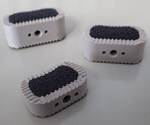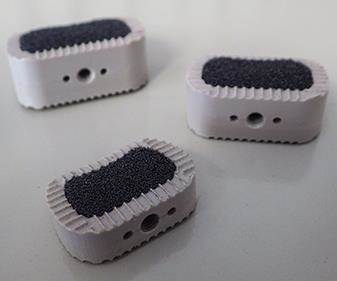Generative Orthoses project to reshape orthopedic care
CRP Technology, MHOX and Istituto Ortopedico Rizzoli, one of the winners of the WORTH Partnership Project II, have developed bespoke orthoses using generative design, Windform GT fiberglass materials and PBF.
Source (All Images) | CRP Technology
CRP Technology (Modena, Italy) and , a design research group with a focus on generative design and 3D printing, in collaboration with (IOR, Bologna, Italy), are one of 69 winning projects under the WORTH Partnership Project II 3rd Call. The project, Generative Orthoses, was awarded for its use of additive technologies and high-performance composite materials to reshape orthopedic care.
The WORTH II 3rd Call saw record-breaking participation, with 142 applications and 320 applicants from 34 EU-COSME-associated countries. After a rigorous evaluation process, 69 projects were selected for funding, featuring 158 partners from 25 countries across Europe.
Over the past 8 years, MHOX, CRP Technology and Istituto Ortopedico Rizzoli have worked together to develop high-performance bespoke orthoses using body scanning, 3D digital design, CRP Technology’s glass fiber-reinforced Windform GT composite material and the additive powder bed fusion (PBF) process. The project incorporates biomimetic design and advanced manufacturing techniques, improving both form and function while providing essential support, rehabilitation and postural correction.
Using 3D printing in generative orthotics involves several major phases:
- Scanning of the patient’s limb
- Generating the 3D model of the orthosis
- Construction of the orthosis using Windform materials and additive manufacturing.
MHOX Design handled the first two stages by developing and using software designed for the automated management of systems for mass product customization.
The procedure requires the digital uploading of the patient’s limb that the orthosis is to fit, using scanning processes based mainly on infrared technology or structured light. The scanning process takes place directly at the doctor, thanks to the portability of the sensor and its plug-and-play features.
Notably, generative design techniques and its simulation of biological phenomena make it possible to reproduce the shape of the orthosis and customize it to fit the patient’s body for subsequent 3D printing. This has led to cost and time reduction, MHOX notes, and the final result mirrors the affected limb without the need for invasive medical examinations.
CRP Technology used Windform GT, a glass fiber-reinforced polyamide for orthoses production. Its elasticity, impermeability and durability, as well as its ability to flex for extended period of time without the risk of damage made it ideal for this type of application. In addition, Windform GT’s strength-to-weight ratio and dimensional stability ensure that the orthotic devices remain lightweight and durable while also being suitable for direct contact with the skin, as it is a skin-proof material.
3D printed generative and bespoke orthoses made in collaboration with MHOX.
CRP notes that the use of PBF is also significant, not just in terms of production speed, product performance and fit, and customization, but also regarding aesthetics for the user.
All developed orthosis solutions have been subjected to a series of tests to assess their performance. The experimentation stage studied static mode, static mode applied to the patient and dynamic mode on the patient. The results have confirmed this new application for Windform materials and technology.
CRP Technology’s research into the manufacturing of generative orthotics has been met with great interest by industry professionals. The same method of construction can be used to make orthoses for upper and lower limbs, plaster casts and prosthetic fairings. CRP Technology and MHOX Design are working alongside professional physical therapists and rehabilitation specialists to investigate the construction of solutions for patients with peroneal nerve dysfunction, resulting in drop foot further to injury, leading to a “slapping” gait.
Looking forward, CRP Technology, MHOX and Istituto Ortopedico Rizzoli continue to refine and automate the design processes, ensuring that the production of fully customized orthotic devices becomes scalable and market-ready for a broader patient base.
Related Content
Collier Aerospace HyperX optimizes X-59 composite nose cone
Swift Engineering relied on the CAE software’s structural sizing, analysis and test validation capabilities to deliver flight hardware for NASA’s supersonic QueSST aircraft early, under budget and with 25% weight savings.
Read MoreNCC leads composites manufacturing phase of eXtra wing demonstrator
Key structural elements for a 6-meter section of the Airbus biomimetic wing were undertaken by NCC engineering specialists to produce 28 one-off flying parts.
Read MoreTesting to support composite bolted joint analysis
An overview of ASTM Standard Guide D8509, and its coupon-level mechanical testing of design properties for analyzing composite bolted joints.
Read MoreCarbon fiber/flax landing gear achieves 54% weight reduction via tailored layup optimization
Fuko’s Biogear showcases how strategic composite material distribution and natural fiber damping properties can lightweight and enhance critical aerospace structure performance.
Read MoreRead Next
Orthopedics: Carbon foam fosters bone growth
The Center of Innovation for Biomaterials in Orthopedic Research (CIBOR) at the National Institute for Aviation Research (Wichita, KS, US) has two patents on the use of carbon foam as a bone-graft material to improve success in orthopedic implants.
Read MoreWheelchair racing glove demands met by CRP USA composites
The strength, durability and light weight characteristics of 3D printed Windform XT 2.0 athletic gear facilitates Paralympics Gold Medalist Tatyana McFadden’s enhanced agility and comfort.
Read MoreScaling up, optimizing the flax fiber composite camper
Greenlander’s Sherpa RV cab, which is largely constructed from flax fiber/bio-epoxy sandwich panels, nears commercial production readiness and next-generation scale-up.
Read More












